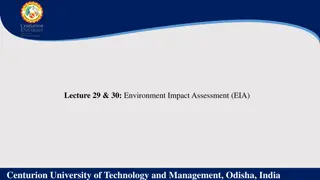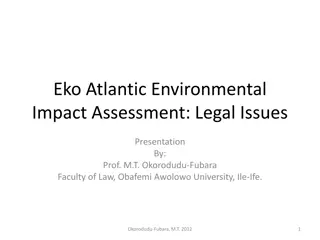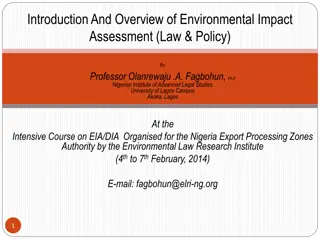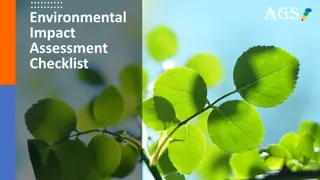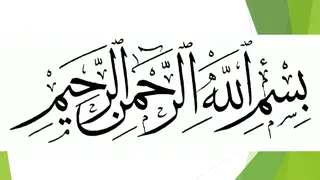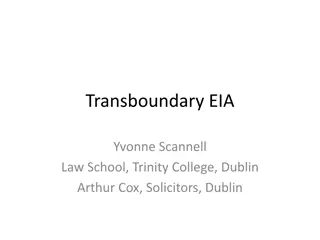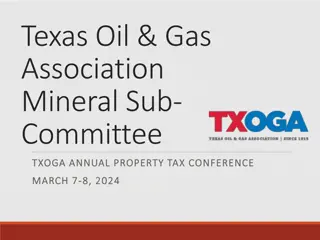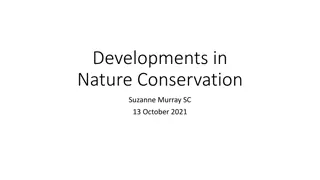Key Aspects of Environmental Impact Assessment (EIA) Review Process
The Environmental Impact Assessment (EIA) review process plays a crucial role in evaluating the environmental, social, and economic impacts of proposed projects. It involves assessing the adequacy of reports, ensuring stakeholder involvement, and verifying the sufficiency of information for decision-making. Various stages like screening, scoping, and monitoring are conducted to maintain quality control in the EIA process. Factors considered during EIA review include adherence to Terms of Reference, scientific accuracy of information, stakeholder input, and commitment to mitigation measures.
Download Presentation

Please find below an Image/Link to download the presentation.
The content on the website is provided AS IS for your information and personal use only. It may not be sold, licensed, or shared on other websites without obtaining consent from the author. Download presentation by click this link. If you encounter any issues during the download, it is possible that the publisher has removed the file from their server.
E N D
Presentation Transcript
EIA approval process, Management plan and Monitoring
Review Review is a process that determines whether the impact assessment reports assessed the environmental social and economic effects and are of sufficient relevance and quality for decision-making. have adequately
Objectives of EIA Review There are 3 broad objectives Determining whether the reports provide an adequate assessment of potential environmental and social implications of a proposed project; 1 Ensuring that reports address all key issues, including the consideration of project alternative and designs . Ensuring that the EIA complies with the Terms of References (ToR).
2 To provide an opportunity for stakeholder and public involvement by; Ensuring that key stakeholders have not only been consulted, but also participated in the EIA process. Allowing stakeholders and public to comment and voice their opinion on reports especially EIA.
3 To ensure adequacy of the report and sufficiency of information for decision making by; Identifying gaps and further information needed for decision making, Presentation of clear, logical and explicit findings.
Quality Control in EIA Process Screening stage to decide on the appropriate level of environmental assessment Scoping stage to define main problems likely impacts and data requirements Review of EIA to evaluate the adequacy and sufficiency of reports/information for decision making. Monitoring and audit stages to assess level of compliance with project design and implementation and check on the adherence to environmental standards and legislation
Factors to be considered when reviewing EIA The report has adequately addressed the terms of reference (ToRs) There is sufficient information on the objectives of the proposal and its environmental setting, consideration of alternatives, impacts, mitigation and monitoring. The information is correct, scientifically and technically sound. The EIA process has been conducted appropriately, and the points of all parties involved have been taken into account. Information presented is relevant, concise, logical, understandable to both decision makers and the public Commitment to mitigation measures, environmental management and monitoring plans are in place.
Tools Guidelines for review Checklist of environmental characteristics Checklist of activities Checklist of compliance with ToR Checklist for data management Site verification visits Checklist for data. Guidelines for screening Guidelines for scoping Guidelines for reporting
Steps involved in organizing the review of EIA reports Set the scale and depth of review Inform reviewers. Make necessary arrangements to co-opt additional members. Use input from stakeholders. Identify review criteria. Organize site visit. Carry out an internal scrutiny . Carry out the review by Multi-sectoral Tech. Review Committee. Determine the required remedial measures. Give recommendations. Publish the review report.
Review Criteria 1. Review Area I: Description of the Development, Local Environment and Baseline Conditions. Review Area II: Identification and Evaluation of Key Impacts. 2. Review Area III: Alternatives, Mitigation and Commitment to Alternatives. 3. Review Area IV: Public Participation and Communication of Results 4.
Review Area I: Description of the Development, Local Environment and Baseline Conditions. a) Description of the Development b) Site Description c) Baseline Conditions
Review Area II: Identification and Evaluation of Key Impacts a) Identification of Impacts b) Residual Impacts c) Cumulative impacts d) Prediction of Impact Magnitude e) Assessment of Impact Significance
Review Area III: Alternatives, Mitigation and Commitment to Alternatives a) Alternative sites b) Mitigation c) Commitment to Mitigation
Review Area IV: Public Participation and Communication of Results a) Stakeholders participation b) Presentation c) Balance d) Non-technical Executive Summary
Overall Assessment of EIA A. (81% 100 %) Excellent, no task left incomplete B. (71% 80%) Good, only minor omissions and inadequacies C. (61% 70%) Satisfactory despite omissions and inadequacies D (51% 60%) Parts are well attempted but must as a whole be considered just unsatisfactory because of omissions and/or inadequacies E (41% 50 %) Poor, significant omissions or inadequacies F (<41%) Very poor, important tasks poorly done or not attempted If overall performance is below C, then revision should be done.
EIA review procedures Environmental agency Independent panel. Standing commission Inter-agency committee Planning authority.
Recommendations of the review report usually include Environmental clearance/approval with terms and conditions to enable proponent to obtain other necessary licenses/permits. Require submission of additional information Request for a supplementary EIA report In rare cases, the project as formulated may be rejected.
Decision Making Objectives To understand the broad trade-offs that must be made among environmental, economic and social factors applicable during decision-making and condition setting. To make sound decisions on environmental and social acceptability of the proposed development project.
Checks and balances on decision-making No decision will be taken until the EIA report has been received and considered the findings of the EIA report and review are a major determinant of approval and condition setting. Public comment on the EIA report is taken into account in decision-making Approvals can be refused or withheld, conditions imposed, or modifications demanded at the final decision stage. Reasons for the decision and the conditions attached to it are published. There is public right of appeal against the decision.
Monitoring Monitoring is a planned and systematic collection of environmental data to meet specific objectives and environmental needs.
Objectives of Monitoring To ensure that the project complies with the existing environmental standards and limits To ensure that mitigation measures recommended in the EIA are implemented and maintained throughout the operational life of the project . Assess performance and monitor compliance with agreed conditions . Review predicted environmental impacts for the effective management of risks and uncertainties.
Identify trends in impacts. Periodically review and alter impact management plans or activities Verify the accuracy of past predictions of impacts and the effectiveness of mitigation measures. Review the effectiveness of the environmental management
Methods Monitoring requirement should focus on the significant impacts predicted in the EIA. i. The environmental values to be safeguarded. ii. The magnitude of each potential impact. iii. The risk or probability of each impact occurring. iv. The pathways and boundaries of each impact. v. The confidence in the prediction of each impact.
Types of monitoring Baseline monitoring. Impacts monitoring. Compliance monitoring. Mitigation monitoring
Environmental Audit Environmental audit is an independent and objective oriented examination of whether the practice complies with expected standards or not. Environmental Impact Audits. Environmental Management Audit. Environmental Impact Audit involves comparing the impacts predicted in an EIS with those that actually occur after implementation of the project Environmental Management Audits focus on public and private corporate structures and programmes for environmental management and the associated risks and liabilities.
Types of Environmental Audit 1. Implementation/enforcement audit 2. Performance/regulatory audits 3. Impact prediction audits
5 groups 5 EIA Report Prepare Review report and Take decision Present your findings.
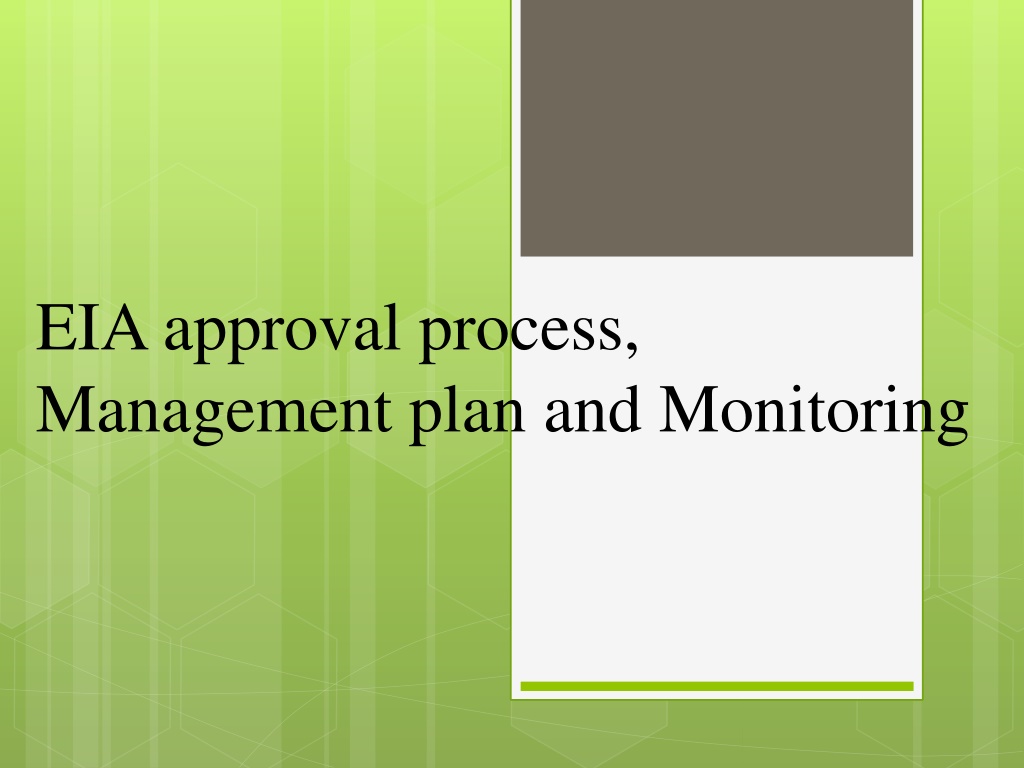
 undefined
undefined















